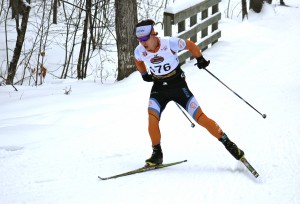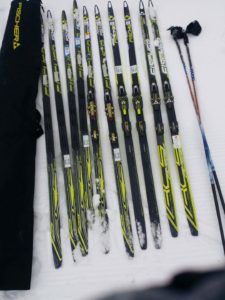–By Kaitlyn Patterson, Team OAM Now skier and cyclist
Cross country skiing is a unique sport and as you get more immersed in the sport, the more quirks arise. For a bit of skiing enlightenment for curious onlookers, I made a list of some of the quirky parts of nordic skiing that make it an intriguing sport.
The challenge of mastering not just one, but two different techniques
Actually, master is a strong word. Most skiers are naturally better at one and often set up their priority races around that strength (at least mortals who are not professional skiers). Key workouts reflect the demands of important races so it can be easy to neglect improving the weaker technique. Some aspects transfer across techniques (strong double poling, weight transfer, cornering) but they are definitely each unique beasts.
Classic-(also known as striding, or kicking and gliding this is often more well-known in the general population)- Although classic skiing might be the easiest to learn, it is probably the hardest to master as there are a lot of technique subtleties that make it far from running on skis. Since there is a lot of double poling in classic races, athletes with strong upper bodies can have great potential, paddlers are an excellent example of this.
Freestyle: (also known as skating, it is similiar to a rollerblading or ice skating motion)- Skating is the faster technique but requires a wide, groomed trail. The technique definitely has a learning curve and is exhausting without technique. But when it is done well, it’s a beautiful thing.
Skiers need an engine, guns, and finesse
If an athlete have at least one these attributes in a sport, they can often be decent. But similiar to swimming, it is harder to get away faking any of them in skiing. Even if a skier has the highest VO2 max on the start line, if he flails around for a couple hours he won’t win. Or even come close. He will likely be mortified that there are people who look much older, bigger, less fit, have two X chromosomes, etc, who are beating him. By a lot.
On the other hand, good technique goes a long way but also takes time, patience and a good coach. Besides a strong aerobic system and technique, you also need to be strong. Skiing places huge demands on muscle groups that are often neglected like the core, shoulders, back and hips.
It helps to be part Eskimo and part physicist
Snow is never just snow. Eskimos have 50 words for snow and skiers essentially do the same thing, just likely not as eloquently. Differences in the snow will influence which glide wax to use to make skis faster or which kick wax to use on classic skis to allow for adequate kick up the hills.
Differences in air temperature, humidity, and how long the snow has been around are all factors in the structure of the snow and therefore how it interacts with the base of your ski. At recreational levels, using the temperature to pick which wax is just fine, but at the highest level (and budget) all these factors will come into play to select the fastest skis and wax.
As much as some people (like me) hate to admit that equipment matters, wax and skis are a huge factor in skiing and can make the difference between the race of your life and a terrible race, even with the same output from the athlete.
Unpredictable weather is a significant source of anxiety
Because of the importance of ski and wax selection in racing, the weather plays a huge factor. Weather forecasts are not necessarily known for their impeccable accuracy and when a race is riding on it, this can be a stressful state of affairs. Similar anxiety strikes with especially weird weather or drastic temperature changes over the course of the race.
For example, a conversation en route to a race watching the thermometer on the car might sound like this. “It’s too cold, it wasn’t supposed to be this cold. Think we will have time to rewax when we get there? Why can’t they ever get it right?!”
Marathons require ninja fueling skills.
Ever try handling a cylindrical object with 5 foot sticks strapped to your hands while traveling at 10+ miles per hour at 80-90% max HR? Enough said. Fueling requires practice and attention to logistical challenges. Bottles freeze, camelbak hoses freeze and cold gels change from semisolids to solids. Solutions include insulated bottles, awesome friends or family willing to do bottle handoffs, and practice with a drink belt and gels that remain accessible.
Skiing easy demands skiing verrry sloooowly
Since it is such a full-body, demanding activity, it can be hard to ski easy enough to be considered recovery. It can be done, but is easier alone and if necessary not uploaded to Strava (check out Elaine’s blog post on that topic!)
Although it might sound like an overly technical and intimidating sport, cross country skiing can be an accessible and enjoyable form of cross training, recreation or competition. The quirky technicalities of the sport at higher levels are fun to some but are not a barrier to enjoying the woods at any speed.













